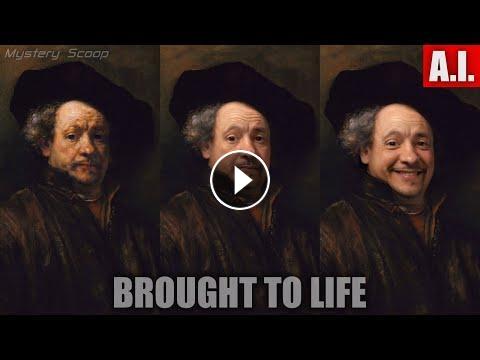The photo of the subject has been digitally manipulated and brought to life using AI technology (neural networks). Image has been enhanced, colorized and facial motion added (including smiling, ageing etc.), using AI tools and Photoshop. This video is part of a series where historical figures are brought to life using AI technology. AI recreated portraits may not be historically accurate.
Rembrandt Harmenszoon van Rijn (15 July 1606 – 4 October 1669, aged 63), was a Dutch Golden Age painter, printmaker and draughtsman. An innovative and prolific master in three media, he is generally considered one of the greatest visual artists in the history of art and the most important in Dutch art history. Unlike most Dutch masters of the 17th century, Rembrandt's works depict a wide range of style and subject matter, from portraits and self-portraits to landscapes, genre scenes, allegorical and historical scenes, and biblical and mythological themes as well as animal studies. His contributions to art came in a period of great wealth and cultural achievement that historians call the Dutch Golden Age, when Dutch art (especially Dutch painting), although in many ways antithetical to the Baroque style that dominated Europe, was extremely prolific and innovative and gave rise to important new genres. Like many artists of the Dutch Golden Age, such as Jan Vermeer of Delft, Rembrandt was also an avid art collector and dealer.
Known for his self-portraits and biblical scenes, Dutch artist Rembrandt is considered to be one of the greatest painters in European history.
Rembrandt settled permanently in Amsterdam in 1631 and set up as a portrait painter. One of his first major public commissions was 'The Anatomy Lesson of Dr Tulp' (1632). In 1634, he married the well-connected Saskia van Uylenburgh. Rembrandt prospered, painting mythological and religious works as well as portraits, and the couple lived well. Rembrandt was 28 when he married Saskia in 1634; 36 when she died (1642), leaving him with a baby son and a sorrow so destructive he gave up painting in oils for several years. Rembrandt and Saskia had four children, but only Titus, born in 1641, survived infancy.
---
- Category
- Variety
- Tags
- mystery scoop, rembrandt, rembrandt painter, rembrandt dutch painter, dutch painter, painter, 17th century painter, dutch golden age art, dutch golden age painting, dutch, painting, ai, ai animation, historical figures brought to life, brought to life, brought to life ai, rembrandt van rijn, rembrandt paintings, art history, art, amsterdam, rembrandt night watch, rembrandt arte, rembrandt painting, oil painting, portrait painting, self-portrait, 17th century artists














Very well done. It is really neat that this can be done.